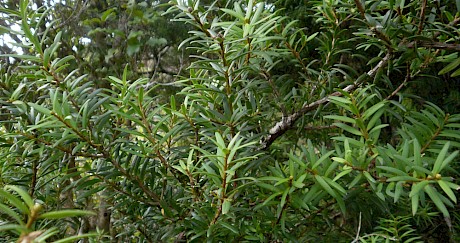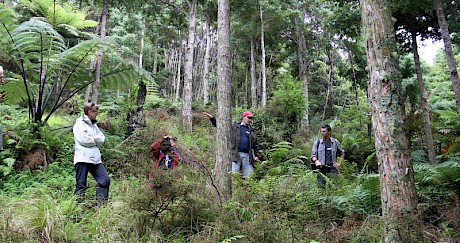Taraire (Beilschmiedia tarairi)
Introduction
Taraire is a member of the Family Lauraceae which is mainly confined to tropical and subtropical areas; probably the best known member of the family being the bay laurel, Laurus nobilis. New Zealand has three tree species, tawa, taraire and mangeao plus the parasitic liane Cassythea.
History
There are no records of the Maori having used taraire for medicinal purposes but the berries were eaten; the kernel after roasting or boiling. Neither did the Maori use taraire wood and likewise the European, since the timber is non durable and only came to be accepted with the advent of boron diffusion treatment. From the 1950s it has been used for flooring, furniture, turnery and mouldings.
Distribution
Taraire grows only in the north of New Zealand; from North Cape south to Raglan and East Cape. It is most abundant between the Kaipara and the Bay of Islands. The species forms the commonest understory species in kauri forest but also is the dominant species in some lowland forests eg, Kirks’s Bush, Papakura. Taraire is found up to 650 metres but is only abundant below 450 metres. It grows best on well drained, fertile soils and does not tolerate poor drainage or very dry sites.
Tree size and growth
Allan records taraire growing to 22 metres tall and 90 to 100 cm diameter. Two are recorded in Burstall and Sale, at Whangarei and Cornwall Park, Auckland, but they are smaller. The largest measured is in Kirk’s Bush and is 20.5 metres tall, is 107 cm in diameter and has a trunk height of 14 metres. Growth data for planted trees is limited to three small groups, two in Auckland and one in Palmerston North. All trees have a mean annual height growth rate of 0.22 to 0.27 metres. The Auckland trees have a diameter annual increment of between 0.8 and 1 cm while the southern trees (outside the natural range) only grow at 0.23 cm per annum. The growth rate is probably faster than tawa but no comparative data is available for tawa.
Timber
Timber characteristics, with P radiata figures shown in brackets for comparison, are as follows: -
Density: 675 kg/ m³ (500 kg/m3³)
Moisture content: green heart 104 % (130%)
Tangential shrinkage -green to 12% m.c 5.4 % (4.7%)
Radial shrinkage 3.0% (2.2%)
Modulus of rupture 94 Mpa (90 Mpa)
Modulus of elasticity 10.8 Gpa (9 Gpa)
The heartwood is an even light brown colour and the sapwood pale. It splits easily and has a good natural finish. Very similar to tawa.
Fruit
The fruit of the taraire is a large fleshy drupe up to 4 cm long and is ripe in late spring to early summer. At this time it is an important food for kereru which also spread the seed effectively throughout the forest.
Potential
This is a species which is unlikely to be planted on a large scale because of its requirement for soil of reasonable quality. It may have potential as a companion species for kauri, with which it is commonly associated in nature. The timber has potential for high quality, decorative uses
Research requirements
More data on growth rates is needed and trials on soil of good quality should be established. Its potential growth rate of 1 cm diameter or higher indicates the potential to produce millable logs in 50 years. The ecology of the species is poorly understood, especially its relationship with kauri, and investigation is needed into this aspect.
References
Allan H H. 1961. Flora of New Zealand Vol. 1 Government Printer Wellington
Brooker S G, Cambie R C & Cooper R C 1981. New Zealand Medicinal Plants. Heinmann
Brooker S G, Cambie R C & Cooper R C 1988. Economic native plants of NewZealand. Botany Division D.S.I.R
Burstal S W & Sale E V 1984. Great Trees of New Zealand
Clifton N C 1990. New Zealand timbers GP Publications
Hinds H V & Reid J S 1957. Forest Trees and Timbers of New Zealand. Govt Printer. Wellington
Pardy G F, Bergin D O & Kimberley M 1992. Survey of Native tree plantations. FRI Bulletin 175
Species profile by Ian Barton


